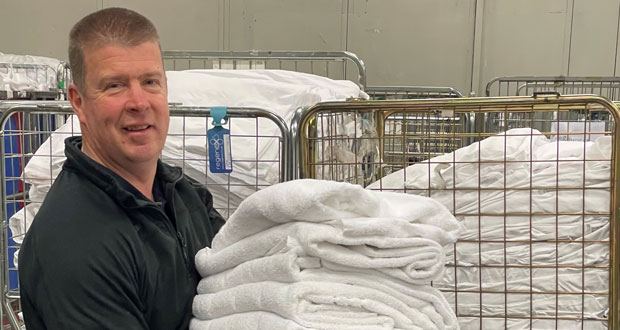The hospitality industry has always ‘done its duty’ to the environment by recycling old linen for rag, rather than sending this straight to landfill. However, as it’s simply not viable to refrain from using any of the earth’s resources to manufacture the material in the first place, re-using linen for as long as possible is the next best option.
A recent report from UNEP 2017, looking at Swedish LCA (Life Cycle Analysis), stated that if one in five garments had their life extended by just 10 per cent, then an estimated 64 million tonnes of textiles would be diverted from landfill each year.
Paul Hamilton, Technical Director at industrial linen stain removal company Regenex (pictured above), discusses how hospitality businesses can cut costs in the long-term and boost their sustainability rankings by getting the most out of their existing laundry stock.
Long-term cost savings
The value of linen in a standard hotel room is approximately the same as the price a customer pays for a night’s stay. The bedding and towels in a ‘mid-range’ room – with two sheets, a quilt cover, four pillowcases, two bath sheets, two bath towels, and a bathmat – would cost over £50 at current bulk wholesale rates. That’s the equivalent of a stay at a budget chain during an off-peak night. Where linen is of higher quality and rooms are more expensive for guests, the equivalent numbers are still similar.
While a marked sheet or dirty bath towel might not seem costly to replace, those amounts can soon add up. The constant replacement of linen can ultimately affect a hotel’s bottom line if unnecessary spending is taking place on ‘top up’ items.
Studies have also shown that new fabrics shed the greatest amount of microplastics in their first few washes. Emissions decrease dramatically after five washes – so it is purely new linen that causes the bulk of this problem.
If hospitality businesses choose to revive their stained linen, rather than condemning it to landfill, they will save substantial costs on replacing their linen closets with new items in the long term. If stubborn marks cannot be lifted, then alternative methods, such as dyeing the material a different colour, should be considered to avoid further textile waste.
Boosts green credentials
When hotels make the most out of their existing linen supply, this not only saves money in the long run, it saves carbon too. While recycling most definitely has its place when it comes to sustainable waste management practices, this also requires another process to move the material to its next lifestage, which means additional water and carbon must be used.
Currently, it is estimated that only one in five pieces of commercial linen sees out its full service, meaning that the majority of this resource is being ragged too early, due to marks or tears.
However, there are environmentally better ways to deal with the excess tonnage of linen that fails to meet inspection in UK laundries each year, rather than simply throwing it into receptacles marked ‘recycling’.
Times are changing and the catering and hospitality sector understands that every item counts. Off-white or heavily stained materials that used to be condemned can now be revived, with specialist treatment to open fibres and remove discoloration, due to advancing technology.
To find out more about how the hospitality sector can ‘love linen longer’, visit Regenex.co.uk to read the latest whitepaper.





